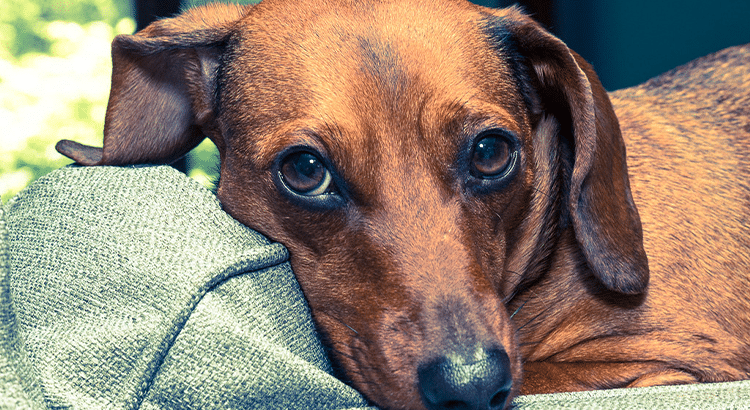
One of the scariest diagnoses to hear come out of a veterinarian’s mouth is IVDD. As with humans, anything related to a spinal injury or disease makes us cringe. The spine is literally the “backbone” of our being and what innervates our limbs with nerves to keep them working. So, what is IVDD and what questions should we ask if our pup is diagnosed with this disease?
What is IVDD?
IVDD stands for intervertebral disc disease. It is a condition where the intervertebral discs between a dog’s spinal vertebrae bulge or burst. Bulging or bursting intervertebral discs can enter the spinal cord space and put pressure on spinal nerves. This can cause wobbling and incoordination, pain, nerve damage, and even lower body paralysis.
What breeds are susceptible to IVDD?
Our vet recently described our dachshund as a “school bus” because of his long body. Although this breed is highly known for developing IVDD, there are other breeds as well that may not come to immediate thought when it comes to this type of disease development. Generally, initial onset occurs between the ages of 3 and 6 years old. The list of inclusive breeds is:
- Bassett Hounds
- Beagles
- Bulldogs
- Corgis
- Cocker Spaniels
- Dachshunds (most common)
- Pekingese
- Poodles
- Shih Tzus
What causes IVDD?
While this is a gradual, degenerative disease, it can lie dormant for many years. This condition rears its ugly face when there is an acute injury resulting in pain and mobility deficits. The spinal cord is unable to function at normal capacity due to a disc herniation, with 80% occurring in the thoracic (middle) region of the spine.
According to VSC Vets, there are different types of IVDD:
“There are two types of intervertebral disc disease (IVDD). The first (type 1) is characterized by rupture of the middle part of the disc (the nucleus pulposus) through tears in the outer part of the disc (the annulus fibrosis). This is also known as a “slipped” disc. This type of disc disease occurs secondary to abnormal degeneration of the nucleus pulposus, where it loses its normal water content and becomes firm or “calcified.” Calcified disc material can be seen on plain X-rays in some dogs. This type of disc disease is characterized by a more sudden inability to walk and may occur anywhere along the length of the spine. Approximately 80 percent of disc herniations occur in the middle part of the back. Type 1-disc disease occurs most commonly in small-breed dogs, such as the Dachshund, Pekingese, Shih Tzu, Toy or Miniature Poodle, Cocker Spaniel, Basset Hound, Chihuahua, and Beagle. However, it can occur in some large-breed dogs, including the Labrador Retriever, German Shepherd, Dalmatian, Pit Bull Terrier, and Rottweiler. This type of disc herniation occurs most commonly in young- to middle-aged dogs.
Type 2-disc disease is caused by chronic bulging of the outer part of the disc on the spinal cord. The condition is typically slowly progressive and may or may not be painful. It occurs most commonly in middle- to older age large-breed dogs. The chronic spinal cord compression with this type of disc disease often causes atrophy of the spinal cord.”
What are the signs and symptoms of IVDD?
As pet owners, we are sensitive to the normal behaviors of our pets. When the typical movements and habits of our pets are abnormal, we take note. A pet who may be experiencing IVDD may be reluctant to move or shake as normal or have decreased vocal initiation of barking/ whining and crying which can both be signs of pain. Sensitivity to touch can be a sign of pain, deficits in walking abilities, a hunched back, muscle spasms or paw knuckling (dragging of the paws when walking). These are only a few of the signs and symptoms of IVDD. As the disease progresses, more involved signs and symptoms may include severe pain, inability to walk, incontinence of bowel and bladder, decreased appetite and loss of deep sensation. Presence of an arched back also indicates the pet may be trying to take pressure off the spine and disc. Here is a list of things to look out for:
- Wobbling when walking
- Reduced activity level; unwillingness to jump or even stand up
- Weakness or incoordination in the rear legs
- Paralysis; dragging one or both rear legs when walking
- Whimpering or crying, especially when moved or touched
- Muscle spasms and/or stiffness in neck or back
- Arched or hunched back (sign of cervical disc problem)
- Reduced appetite
- Lack of control over urination or defecation (incontinence)
What are the stages of IVDD?
Stage 1 Mild pain and usually self-correcting in a few days
Stage 2 Moderate to severe pain in the neck or low back area
Stage 3 Partial paralysis causing trouble walking and/or uncoordinated movements
Stage 4 Paralysis but with the ability to feel
Stage 5 Paralysis with the loss of all feeling
Stage 1 may not require any intervention while stages 2-3 may require oral non-steroidal anti-inflammatories, neurological pain medications, opioids, support supplements, physical therapy, dieting, acupuncture, laser therapy, and other multi-modal treatment options.
There is no linear progression of the disease. A dog may quickly progress from Stage 1 to Stage 5 or show signs of a more progressive stage from the beginning without showing any signs of the first stages.
How is IVDD diagnosed?
A vet or neurologist will diagnose the pet through physical examination and further non-invasive testing. Through the use of the following tests, IVDD or lack thereof will be determined:
Myelogram– dye injected into the spinal cord with use of x-rays to look for spinal canal problems
Spinal Radiographs– a photographic or digital image of the internal composition of the body
MRI– uses powerful magnets, radio waves, and a computer to make detailed pictures inside the body
CT– uses computers and rotating X-ray machines to create cross-sectional images of the body
A full neurological exam by a neuro specialist with hands on palpations and manual testing
How much does IVDD surgery cost?
As with any surgery, the cost can vary depending on breed, size and severity of the disease. The cost can range from $1,500 to $4,000*. (* Each clinic will vary on cost which could be higher or lower than the numbers reported here).
Can dogs recover from this disease?
Yes, dogs are able to recover from IVDD. When surgical intervention is not necessary, other modalities may be used to help your pet begin their road to recovery. Bedrest may assist in reversing IVDD or minimizing the signs and symptoms. The use of pain-relieving medications, safe exercise and supportive care can be used to start their recovery plan.
Tips on trying to prevent IVDD?
- Keep your dog’s weight within a healthy range for their breed.
- Limit your pet’s jumping and utilize ramps for couch, bed and stair transfers.
- Minimize your pets running activities, especially at fast speeds to chase a ball or squirrel.
- Use a harness rather than a neck collar to minimize stresses to the neck.
- Avoid tug-of-war play activities which will cause stress on the neck and spine.
- Do not let them sit up on their bottom in a begging position.
If your dog is displaying signs and symptoms of IVDD, please call your vet immediately.
Table of content
Related articles

One of the scariest diagnoses to hear come out of a veterinarian’s mouth is IVDD. As with humans, anything related to a spinal injury or disease makes us cringe. The spine is literally the “backbone” of our being and what innervates our limbs with nerves to keep them working. So, what is IVDD and what questions should we ask if our pup is diagnosed with this disease?
What is IVDD?
IVDD stands for intervertebral disc disease. It is a condition where the intervertebral discs between a dog’s spinal vertebrae bulge or burst. Bulging or bursting intervertebral discs can enter the spinal cord space and put pressure on spinal nerves. This can cause wobbling and incoordination, pain, nerve damage, and even lower body paralysis.
What breeds are susceptible to IVDD?
Our vet recently described our dachshund as a “school bus” because of his long body. Although this breed is highly known for developing IVDD, there are other breeds as well that may not come to immediate thought when it comes to this type of disease development. Generally, initial onset occurs between the ages of 3 and 6 years old. The list of inclusive breeds is:
- Bassett Hounds
- Beagles
- Bulldogs
- Corgis
- Cocker Spaniels
- Dachshunds (most common)
- Pekingese
- Poodles
- Shih Tzus
What causes IVDD?
While this is a gradual, degenerative disease, it can lie dormant for many years. This condition rears its ugly face when there is an acute injury resulting in pain and mobility deficits. The spinal cord is unable to function at normal capacity due to a disc herniation, with 80% occurring in the thoracic (middle) region of the spine.
According to VSC Vets, there are different types of IVDD:
“There are two types of intervertebral disc disease (IVDD). The first (type 1) is characterized by rupture of the middle part of the disc (the nucleus pulposus) through tears in the outer part of the disc (the annulus fibrosis). This is also known as a “slipped” disc. This type of disc disease occurs secondary to abnormal degeneration of the nucleus pulposus, where it loses its normal water content and becomes firm or “calcified.” Calcified disc material can be seen on plain X-rays in some dogs. This type of disc disease is characterized by a more sudden inability to walk and may occur anywhere along the length of the spine. Approximately 80 percent of disc herniations occur in the middle part of the back. Type 1-disc disease occurs most commonly in small-breed dogs, such as the Dachshund, Pekingese, Shih Tzu, Toy or Miniature Poodle, Cocker Spaniel, Basset Hound, Chihuahua, and Beagle. However, it can occur in some large-breed dogs, including the Labrador Retriever, German Shepherd, Dalmatian, Pit Bull Terrier, and Rottweiler. This type of disc herniation occurs most commonly in young- to middle-aged dogs.
Type 2-disc disease is caused by chronic bulging of the outer part of the disc on the spinal cord. The condition is typically slowly progressive and may or may not be painful. It occurs most commonly in middle- to older age large-breed dogs. The chronic spinal cord compression with this type of disc disease often causes atrophy of the spinal cord.”
What are the signs and symptoms of IVDD?
As pet owners, we are sensitive to the normal behaviors of our pets. When the typical movements and habits of our pets are abnormal, we take note. A pet who may be experiencing IVDD may be reluctant to move or shake as normal or have decreased vocal initiation of barking/ whining and crying which can both be signs of pain. Sensitivity to touch can be a sign of pain, deficits in walking abilities, a hunched back, muscle spasms or paw knuckling (dragging of the paws when walking). These are only a few of the signs and symptoms of IVDD. As the disease progresses, more involved signs and symptoms may include severe pain, inability to walk, incontinence of bowel and bladder, decreased appetite and loss of deep sensation. Presence of an arched back also indicates the pet may be trying to take pressure off the spine and disc. Here is a list of things to look out for:
- Wobbling when walking
- Reduced activity level; unwillingness to jump or even stand up
- Weakness or incoordination in the rear legs
- Paralysis; dragging one or both rear legs when walking
- Whimpering or crying, especially when moved or touched
- Muscle spasms and/or stiffness in neck or back
- Arched or hunched back (sign of cervical disc problem)
- Reduced appetite
- Lack of control over urination or defecation (incontinence)
What are the stages of IVDD?
Stage 1 Mild pain and usually self-correcting in a few days
Stage 2 Moderate to severe pain in the neck or low back area
Stage 3 Partial paralysis causing trouble walking and/or uncoordinated movements
Stage 4 Paralysis but with the ability to feel
Stage 5 Paralysis with the loss of all feeling
Stage 1 may not require any intervention while stages 2-3 may require oral non-steroidal anti-inflammatories, neurological pain medications, opioids, support supplements, physical therapy, dieting, acupuncture, laser therapy, and other multi-modal treatment options.
There is no linear progression of the disease. A dog may quickly progress from Stage 1 to Stage 5 or show signs of a more progressive stage from the beginning without showing any signs of the first stages.
How is IVDD diagnosed?
A vet or neurologist will diagnose the pet through physical examination and further non-invasive testing. Through the use of the following tests, IVDD or lack thereof will be determined:
Myelogram– dye injected into the spinal cord with use of x-rays to look for spinal canal problems
Spinal Radiographs– a photographic or digital image of the internal composition of the body
MRI– uses powerful magnets, radio waves, and a computer to make detailed pictures inside the body
CT– uses computers and rotating X-ray machines to create cross-sectional images of the body
A full neurological exam by a neuro specialist with hands on palpations and manual testing
How much does IVDD surgery cost?
As with any surgery, the cost can vary depending on breed, size and severity of the disease. The cost can range from $1,500 to $4,000*. (* Each clinic will vary on cost which could be higher or lower than the numbers reported here).
Can dogs recover from this disease?
Yes, dogs are able to recover from IVDD. When surgical intervention is not necessary, other modalities may be used to help your pet begin their road to recovery. Bedrest may assist in reversing IVDD or minimizing the signs and symptoms. The use of pain-relieving medications, safe exercise and supportive care can be used to start their recovery plan.
Tips on trying to prevent IVDD?
- Keep your dog’s weight within a healthy range for their breed.
- Limit your pet’s jumping and utilize ramps for couch, bed and stair transfers.
- Minimize your pets running activities, especially at fast speeds to chase a ball or squirrel.
- Use a harness rather than a neck collar to minimize stresses to the neck.
- Avoid tug-of-war play activities which will cause stress on the neck and spine.
- Do not let them sit up on their bottom in a begging position.
If your dog is displaying signs and symptoms of IVDD, please call your vet immediately.

One of the scariest diagnoses to hear come out of a veterinarian’s mouth is IVDD. As with humans, anything related to a spinal injury or disease makes us cringe. The spine is literally the “backbone” of our being and what innervates our limbs with nerves to keep them working. So, what is IVDD and what questions should we ask if our pup is diagnosed with this disease?
What is IVDD?
IVDD stands for intervertebral disc disease. It is a condition where the intervertebral discs between a dog’s spinal vertebrae bulge or burst. Bulging or bursting intervertebral discs can enter the spinal cord space and put pressure on spinal nerves. This can cause wobbling and incoordination, pain, nerve damage, and even lower body paralysis.
What breeds are susceptible to IVDD?
Our vet recently described our dachshund as a “school bus” because of his long body. Although this breed is highly known for developing IVDD, there are other breeds as well that may not come to immediate thought when it comes to this type of disease development. Generally, initial onset occurs between the ages of 3 and 6 years old. The list of inclusive breeds is:
- Bassett Hounds
- Beagles
- Bulldogs
- Corgis
- Cocker Spaniels
- Dachshunds (most common)
- Pekingese
- Poodles
- Shih Tzus
What causes IVDD?
While this is a gradual, degenerative disease, it can lie dormant for many years. This condition rears its ugly face when there is an acute injury resulting in pain and mobility deficits. The spinal cord is unable to function at normal capacity due to a disc herniation, with 80% occurring in the thoracic (middle) region of the spine.
According to VSC Vets, there are different types of IVDD:
“There are two types of intervertebral disc disease (IVDD). The first (type 1) is characterized by rupture of the middle part of the disc (the nucleus pulposus) through tears in the outer part of the disc (the annulus fibrosis). This is also known as a “slipped” disc. This type of disc disease occurs secondary to abnormal degeneration of the nucleus pulposus, where it loses its normal water content and becomes firm or “calcified.” Calcified disc material can be seen on plain X-rays in some dogs. This type of disc disease is characterized by a more sudden inability to walk and may occur anywhere along the length of the spine. Approximately 80 percent of disc herniations occur in the middle part of the back. Type 1-disc disease occurs most commonly in small-breed dogs, such as the Dachshund, Pekingese, Shih Tzu, Toy or Miniature Poodle, Cocker Spaniel, Basset Hound, Chihuahua, and Beagle. However, it can occur in some large-breed dogs, including the Labrador Retriever, German Shepherd, Dalmatian, Pit Bull Terrier, and Rottweiler. This type of disc herniation occurs most commonly in young- to middle-aged dogs.
Type 2-disc disease is caused by chronic bulging of the outer part of the disc on the spinal cord. The condition is typically slowly progressive and may or may not be painful. It occurs most commonly in middle- to older age large-breed dogs. The chronic spinal cord compression with this type of disc disease often causes atrophy of the spinal cord.”
What are the signs and symptoms of IVDD?
As pet owners, we are sensitive to the normal behaviors of our pets. When the typical movements and habits of our pets are abnormal, we take note. A pet who may be experiencing IVDD may be reluctant to move or shake as normal or have decreased vocal initiation of barking/ whining and crying which can both be signs of pain. Sensitivity to touch can be a sign of pain, deficits in walking abilities, a hunched back, muscle spasms or paw knuckling (dragging of the paws when walking). These are only a few of the signs and symptoms of IVDD. As the disease progresses, more involved signs and symptoms may include severe pain, inability to walk, incontinence of bowel and bladder, decreased appetite and loss of deep sensation. Presence of an arched back also indicates the pet may be trying to take pressure off the spine and disc. Here is a list of things to look out for:
- Wobbling when walking
- Reduced activity level; unwillingness to jump or even stand up
- Weakness or incoordination in the rear legs
- Paralysis; dragging one or both rear legs when walking
- Whimpering or crying, especially when moved or touched
- Muscle spasms and/or stiffness in neck or back
- Arched or hunched back (sign of cervical disc problem)
- Reduced appetite
- Lack of control over urination or defecation (incontinence)
What are the stages of IVDD?
Stage 1 Mild pain and usually self-correcting in a few days
Stage 2 Moderate to severe pain in the neck or low back area
Stage 3 Partial paralysis causing trouble walking and/or uncoordinated movements
Stage 4 Paralysis but with the ability to feel
Stage 5 Paralysis with the loss of all feeling
Stage 1 may not require any intervention while stages 2-3 may require oral non-steroidal anti-inflammatories, neurological pain medications, opioids, support supplements, physical therapy, dieting, acupuncture, laser therapy, and other multi-modal treatment options.
There is no linear progression of the disease. A dog may quickly progress from Stage 1 to Stage 5 or show signs of a more progressive stage from the beginning without showing any signs of the first stages.
How is IVDD diagnosed?
A vet or neurologist will diagnose the pet through physical examination and further non-invasive testing. Through the use of the following tests, IVDD or lack thereof will be determined:
Myelogram– dye injected into the spinal cord with use of x-rays to look for spinal canal problems
Spinal Radiographs– a photographic or digital image of the internal composition of the body
MRI– uses powerful magnets, radio waves, and a computer to make detailed pictures inside the body
CT– uses computers and rotating X-ray machines to create cross-sectional images of the body
A full neurological exam by a neuro specialist with hands on palpations and manual testing
How much does IVDD surgery cost?
As with any surgery, the cost can vary depending on breed, size and severity of the disease. The cost can range from $1,500 to $4,000*. (* Each clinic will vary on cost which could be higher or lower than the numbers reported here).
Can dogs recover from this disease?
Yes, dogs are able to recover from IVDD. When surgical intervention is not necessary, other modalities may be used to help your pet begin their road to recovery. Bedrest may assist in reversing IVDD or minimizing the signs and symptoms. The use of pain-relieving medications, safe exercise and supportive care can be used to start their recovery plan.
Tips on trying to prevent IVDD?
- Keep your dog’s weight within a healthy range for their breed.
- Limit your pet’s jumping and utilize ramps for couch, bed and stair transfers.
- Minimize your pets running activities, especially at fast speeds to chase a ball or squirrel.
- Use a harness rather than a neck collar to minimize stresses to the neck.
- Avoid tug-of-war play activities which will cause stress on the neck and spine.
- Do not let them sit up on their bottom in a begging position.



